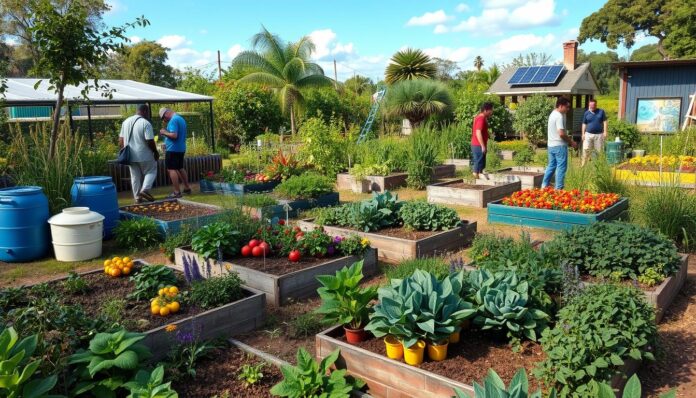Today, over 55% of people live in cities. By 2050, this number will jump to 68%. Cities are big polluters, causing about 70% of global carbon emissions. They also use over 60% of resources.
Havana, Cuba, is a great example. It grows over 90% of its fruits and veggies using permaculture. This boosts the local economy and makes the community stronger.
Permaculture is a smart way to make cities sustainable. It’s a design system for creating green environments. By using permaculture, communities can grow food sustainably, become more resilient, and support a regenerative economy.
Key Takeaways
- Permaculture economic development can help reduce carbon emissions and resource use in urban areas.
- Sustainable agriculture practices are crucial for community resilience and permaculture economic development.
- Urban permaculture strategies can contribute to better waste management and enhanced biodiversity.
- Permaculture initiatives support local food production, fostering local economic development and community resilience.
- Permaculture design can be applied at various scales, from home gardens to entire nations, making it a versatile solution for permaculture economic development.
- Urban permaculture projects can lead to economic savings through reduced waste management and energy consumption costs.
Understanding Permaculture and Its Principles
Permaculture is a design system that aims to create sustainable human environments. It mimics the relationships found in nature. This approach to sustainable agriculture and land management has become popular worldwide.
At its core, permaculture uses land, resources, people, and the environment in a way that minimizes waste. It encourages closed-loop systems found in nature. By adopting permaculture principles, individuals and communities can reduce their environmental footprint and create sustainable livelihoods.
Definition of Permaculture
Permaculture refers to the use of sustainable agriculture and holistic land management techniques. It aims to create diverse and resilient ecosystems. This approach is guided by three core principles: people care, earth care, and fair share.
Core Principles of Permaculture
The core principles of permaculture include:
- People care: caring for the well-being of all individuals involved in the permaculture system
- Earth care: managing the environment in a way that minimizes harm and promotes biodiversity
- Fair share: sharing resources and knowledge fairly and equitably among all members of the permaculture community
Benefits of Permaculture
The benefits of permaculture are numerous. They include enhanced community resilience, regenerative economies, and sustainable livelihoods. By adopting permaculture principles, individuals and communities can:
- Reduce soil erosion and improve soil health
- Promote biodiversity and create diverse ecosystems
- Improve water retention and minimize water usage
- Decrease reliance on chemical fertilizers and pesticides
| Permaculture Principle | Benefit |
|---|---|
| People care | Enhanced community resilience |
| Earth care | Promotion of biodiversity |
| Fair share | Sharing of resources and knowledge |
The Role of Permaculture in Economic Development
Permaculture plays a key role in creating sustainable jobs. It helps local economies grow and supports a greener future. Permaculture focuses on working with nature to produce more and waste less.
Some important strategies for permaculture’s economic growth include:
- Using sustainable farming to cut down on fossil fuel use and boost local food
- Creating jobs in green fields like ecological restoration and renewable energy
- Building local economies through community-supported farms and cooperative businesses
The Global Footprint Network says we need at least 1.7 Earths to keep up with our current use. This shows we need to switch to more sustainable economic ways. Permaculture helps by supporting green jobs and sustainable living, leading to better economic growth.
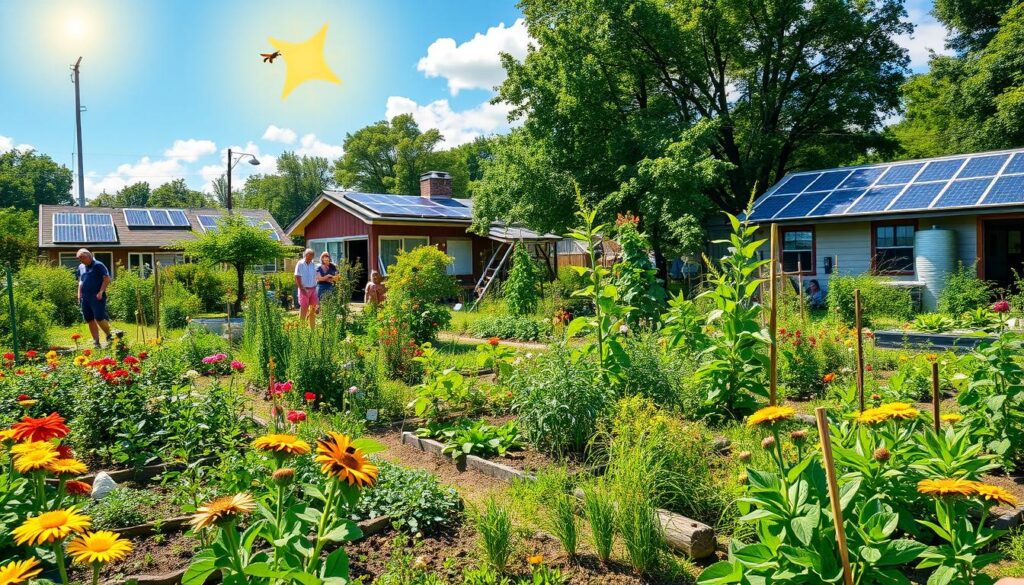
| Strategy | Description |
|---|---|
| Sustainable Agriculture | Reducing reliance on fossil fuels and promoting local food production |
| Green Job Creation | Creating jobs in fields such as ecological restoration, renewable energy, and sustainable building |
| Local Economy Development | Developing local economies through community-supported agriculture programs and cooperative businesses |
Case Studies of Successful Permaculture Initiatives
Permaculture has been a hit in many places, from cities to countryside. It boosts community resilience and supports local food systems. For example, Havana, Cuba, grows over 90% of its fruits and veggies right in the city.
In Seattle, the Beacon Food Forest turned a seven-acre plot into a food forest. It’s a big hit for teaching about food and the environment. These efforts show how permaculture can help people live sustainably and support local food systems.
Permaculture brings many benefits, like:
* Better food security
* More food grown
* Diverse diets
* Jobs that are good for the planet
* Stronger community resilience and local food systems
These examples prove permaculture’s worth. It’s a great way for communities to grow their own food and care for the environment. It’s all about making our food systems better and more sustainable.
Implementing Permaculture in Your Community
Permaculture works on many scales, from small gardens to big nations. It needs a holistic land management way of thinking. By looking at what’s available and getting people excited, you can start permaculture projects. These projects help make communities stronger and support sustainable living.
First, check what resources you have, like land, water, and people. Knowing this helps spot where you can do better and grow. Important things to think about include:
- Climate and soil conditions
- Access to water and irrigation systems
- Existing infrastructure and resources
- Community engagement and participation
Using permaculture ideas, communities can build systems that are good for the planet and people. This way, everyone can grow economically, socially, and environmentally. It’s a step towards a better future for everyone.
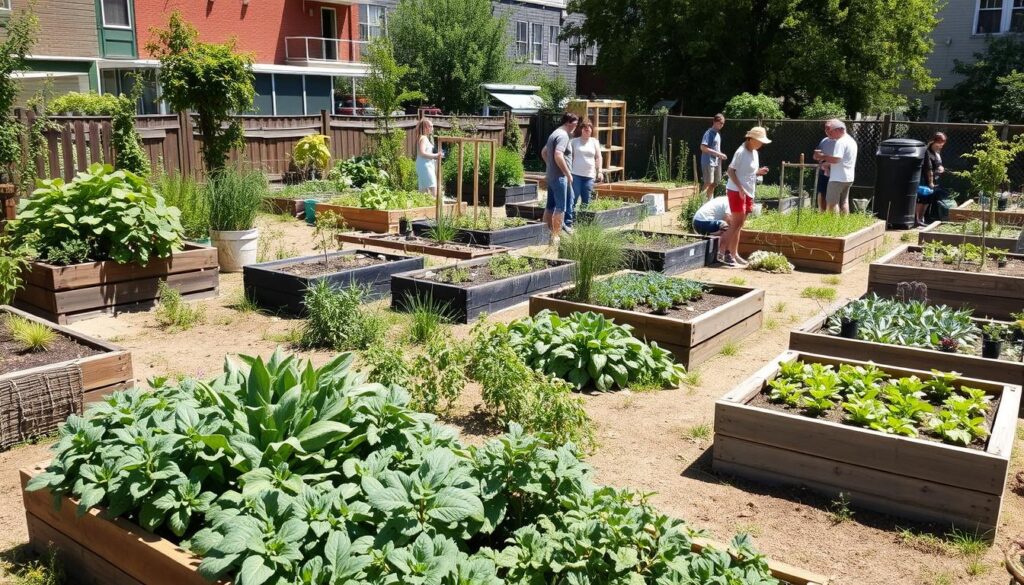
| Permaculture Principle | Description |
|---|---|
| Observe and Interact | Observe and interact with nature to understand its patterns and rhythms. |
| Catch and Store Energy | Catch and store energy from the environment to reduce waste and increase efficiency. |
| Obtain a Yield | Obtain a yield from the system to ensure its sustainability and productivity. |
Creating Permaculture Design Plans
Permaculture design looks at how all parts of a system work together. It uses sustainable agriculture practices and helps communities become stronger. For example, it might include collecting rainwater, recycling waste, and using green energy.
A good permaculture plan brings many benefits. It helps manage land better, increases plant and animal variety, and makes soil healthier. To make a plan, follow the GOBRADIME steps. This means setting goals, observing the land, setting boundaries, finding resources, analyzing weaknesses, designing the plan, and keeping it up.
More details on this process are at permaculture design process.
Some important parts of a permaculture design are:
- Water management systems
- Soil conservation and regeneration strategies
- Biodiversity and ecosystem services
- Renewable energy sources
These parts help make a system that is strong and sustainable. They follow permaculture design principles.
https://www.youtube.com/watch?v=MIA66F9vEfc
By using these elements and good planning, people can make permaculture projects. These projects support sustainable farming, better land use, and stronger communities.
| Element | Description |
|---|---|
| Water Management | Systems for collecting, storing, and distributing water |
| Soil Conservation | Strategies for preserving and regenerating soil health |
| Biodiversity | Practices for promoting ecosystem services and species diversity |
Funding Opportunities for Permaculture Projects
Permaculture projects can get funding from grants, financial aid, and crowdfunding. These funding opportunities help make permaculture practices sustainable. They also help communities become more resilient. Knowing where to find funding is key to starting and keeping up permaculture projects.
Here are some ways to fund permaculture projects:
- Grants from private and government corporations, which require a specific project proposal
- Crowdfunding, which involves pre-purchasing products or services
- Membership programs, which provide recurring donations
- Workshops and teaching classes, which can increase engagement and funds
- Hosting community events, which can quickly raise funds and foster community resilience
To raise funds well, you need a clear project plan. Show how your project will help the community. It’s also important to track how your project is doing. This way, you can make your project better and more successful.
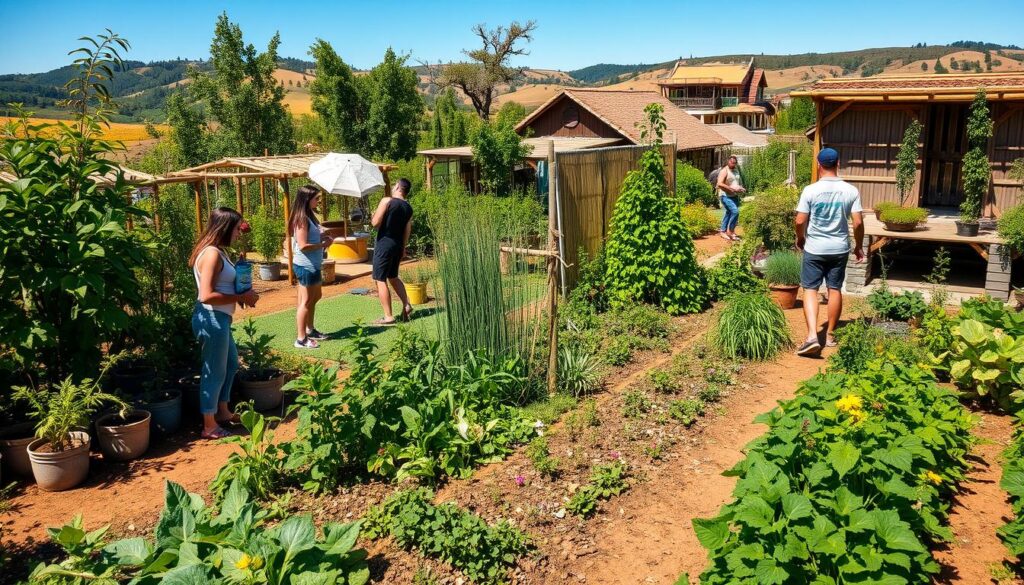
| Project | Funding Source | Amount |
|---|---|---|
| Permaculture Farm | Grant | $10,000 |
| Community Garden | Crowdfunding | $5,000 |
| Workshop Series | Membership Program | $3,000 |
By using these funding options and good fundraising plans, permaculture projects can help create a better future. They also offer green job opportunities for people in the community.
Educational Programs and Workshops
Learning about permaculture is key to a sustainable future. Workshops, skill-sharing events, and community gatherings are great ways to learn. By getting advice from experts, people can pick up the skills needed for permaculture projects. These projects help with sustainable agriculture practices and make communities stronger.
The Four Seasons Permaculture Design Certification Course is a great example. It’s a 100+ hour course with over 35 years of experience. It includes lots of hands-on activities. You’ll learn about water harvesting, sheet mulching, and making compost piles.
Some important things about permaculture education include:
- Hands-on workshops for community engagement
- Learning from experts and practitioners
- Covering topics such as soil building, renewable energy systems, and community building
These programs help graduates make a difference in their local economies. They work towards more fair and green outcomes. By joining these programs, people can learn how to make our future more sustainable.
| Program | Duration | Topics Covered |
|---|---|---|
| Four Seasons Permaculture Design Certification Course | 100+ hours | Soil building, renewable energy systems, community building |
Collaborating with Local Governments
Permaculture can help create sustainable communities when working with local governments. People can team up to find stakeholders and form partnerships. This way, they can start permaculture projects that support sustainable living and make communities stronger.
The city of Tucson, Arizona, is a great example. They teamed up with permaculturists to use rainwater and other green practices.
Local governments can also help with funding and resources for permaculture projects. For instance, the Community Compost and Food Waste Reduction (CCFWR) pilot projects offer up to $2 million. These projects aim to cut down on food waste and make compost more available for farmers.
Here are some successful partnerships between permaculture and local governments:
- The city of Prescott, Arizona, plans to make about 28 tons of compost in two years.
- The Office of Urban Agriculture and Innovative Production was set up in 2018 to support urban farming.
These examples show how permaculture can help communities become more resilient and support economic growth. They also show why working together with local governments is key to achieving these goals.
Marketing Permaculture Products
Marketing is key for permaculture products to succeed. By knowing permaculture well, people can make marketing plans. These plans show how these products help local food systems.
Creating a brand that people can relate to is important. Also, sales strategies should focus on what makes permaculture products special.
Some good marketing ideas for permaculture products are:
- Using local markets to find the right audience
- Being strong online with social media and websites
- Making educational content to teach about permaculture benefits
These strategies help sell permaculture products well. They also help local food systems grow. The aim is to market in a way that’s good for the planet and supports local food systems.
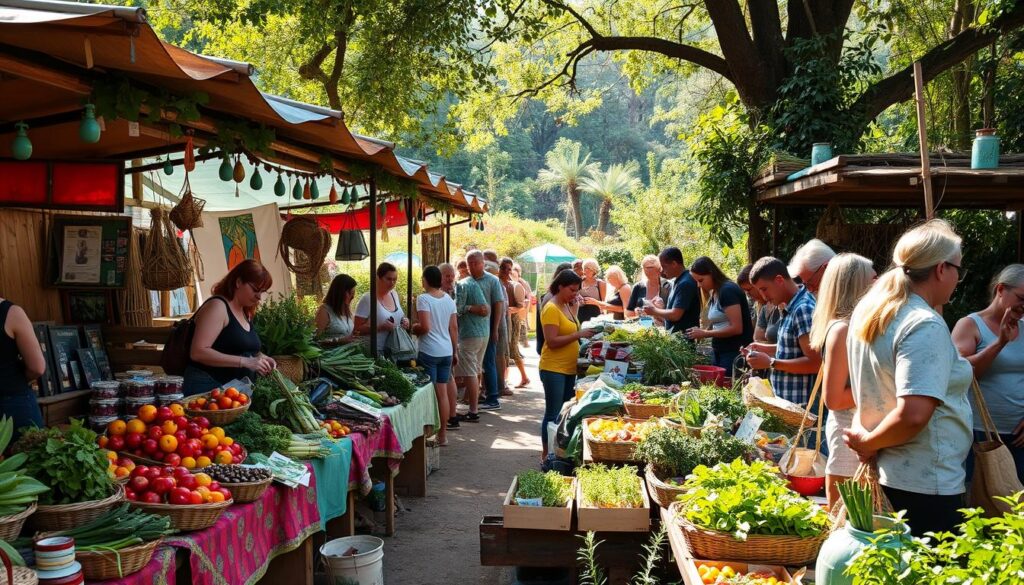
As more people want permaculture products, good marketing is crucial. It should focus on local food systems and green practices. This way, we can build a food system that’s strong and good for the earth and people.
| Marketing Strategy | Benefits |
|---|---|
| Utilizing local markets | More visibility, the right audience, and local economy support |
| Developing a strong online presence | Wider reach, more brand awareness, and better customer interaction |
| Creating educational content | More awareness, higher demand, and better understanding of permaculture products |
Measuring Economic Impact
Permaculture projects can greatly boost local economies. They create jobs and support sustainable living. To see how well they work, we need to track their economic effects.
Important metrics for this include:
- Job creation and retention rates
- Investment in local economies
- Value of new construction and increases in assessed property values
- Hotel occupancy rates and other measures of downtown vitality
These metrics help us understand the economic benefits of permaculture. For instance, the transition town movement tracks jobs, local food, and waste reduction. This shows how well their projects are doing.
Della Duncan, a Gross National Happiness Master Trainer, suggests looking beyond GDP. She recommends using Gross National Happiness as a measure. This way, we can see the true value of permaculture’s impact on people’s lives.
Policy Support for Permaculture Development
Permaculture needs policy support to grow. This support helps make sustainable farming easier. By pushing for good policies, we can help permaculture projects thrive.
Key parts of policy support include:
- Advocacy for permaculture-friendly policies
- Understanding zoning and land use laws
- Support for sustainable agriculture practices
The city of Melbourne, Australia, is a shining example. It has policies that support urban farming and sustainable food. This shows how cities can help permaculture projects grow.
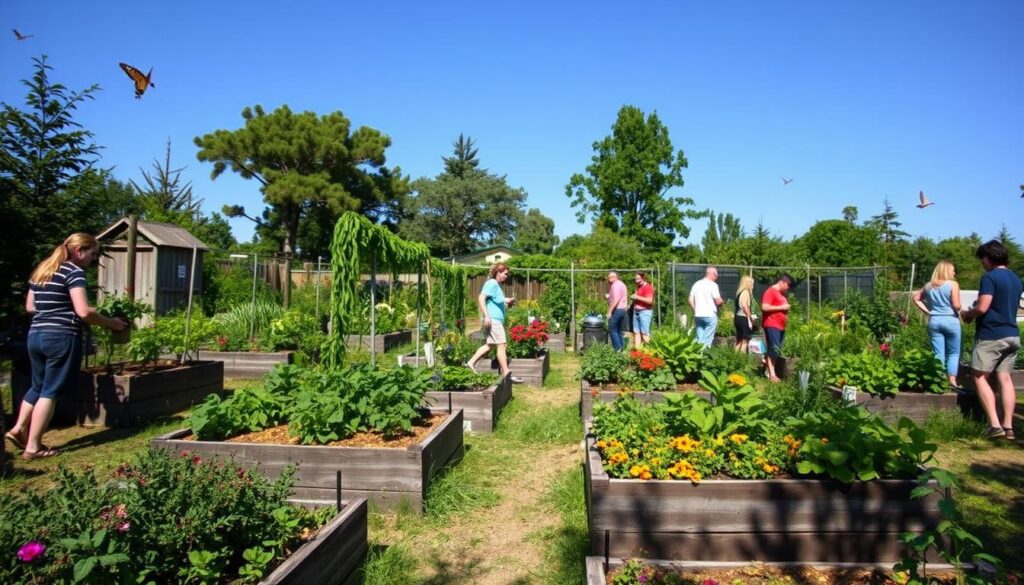
Good policies can also fight environmental problems like soil erosion and water pollution. They encourage farming that’s better for the planet. This leads to more sustainable food systems.
| Policy Support | Benefits |
|---|---|
| Permaculture-friendly policies | Promote sustainable agriculture practices |
| Advocacy for permaculture-friendly policies | Support sustainable livelihoods |
| Understanding zoning and land use laws | Enable permaculture projects |
Challenges in Permaculture Implementation
Starting permaculture projects can be tough. Money and resources are often short, making it hard to succeed. Some people also don’t want to change their ways, which can slow things down.
Here are some common problems and how to solve them:
- Lack of funding: Look for grants, use crowdfunding, or team up with local groups
- Limited resources: Make do with what you have, like using volunteers and local stuff
- Resistance to change: Get people involved in planning and learning about permaculture
Knowing these hurdles and how to beat them helps make permaculture work. Big projects, like those by Beforest Collectives, can make farming better. But, they need a lot of money and hard work at first.
But, permaculture is key for a green future. It helps people live better and stronger together. By facing these challenges, we can build strong, green communities that help everyone.
| Challenge | Solution |
|---|---|
| Lack of funding | Seek grants, crowdfunding, or partnerships |
| Limited resources | Utilize available resources, such as community volunteers and local materials |
| Resistance to change | Engage community members in the design and implementation process, and provide education and training on permaculture principles |
The Future of Permaculture Economic Development
The world faces big environmental and social challenges. But, the future of permaculture economic development looks bright. Trends in sustainability and new technology are making permaculture a key part of sustainable living.
Farmers markets and community food systems are getting more popular after the pandemic. This shows people value sustainable food more. Permaculture, which helps empower local communities and creates strong food systems, is playing a big role in this change.
New tech like precision agriculture and vertical farming is changing permaculture. These advancements make farming more efficient and save resources. They open up new ways for sustainable livelihoods and help local economies grow.

